Ranch's livestock are goodwill ambassadors to the larger community
By JULIE MINDA
MOUNT CALVARY, Wis. — Walk into the entryway of Villa Loretto here, and it is immediately clear that there is something wildly different about this skilled nursing home.
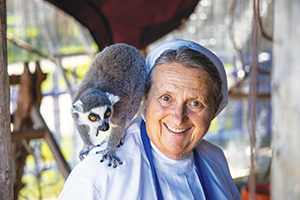
Sr. Stephen Bloesl, a member of the Sister Servants of Christ the King, manages the Cristo Rey Ranch that surrounds a Catholic long-term care campus in Mount Calvary, Wis. Opie, the lemur, is one of the hundreds of animals that live at the ranch.
Photo by Harle Photography, courtesy of Agnesian HealthCare
A resident maneuvers his wheelchair up to a birdcage and strums his fingers along its wires, chattering happily to the parakeets. Nearby, a staff member leads an exuberant dog to a delighted elderly woman in an easy chair. Several paces away, a resident strolls by a second birdcage — this one rises from floor-to-ceiling — peering at the dozen or so birds flitting about inside.
Head out back of Villa Loretto a few steps and find even more surprises: dozens of large pens inhabited by lively pigs, chickens, ducks, rabbits, lemurs and goats; a barn and fields with cows, horses, sheep, alpacas and even a camel ambling about; and beautifully maintained floral gardens and walking paths. All of this is easily accessible to Villa Loretto's dozens of residents, as well as to the residents of its sister assisted living facility nearby, Villa Rosa, and to staff, visitors and the general public.
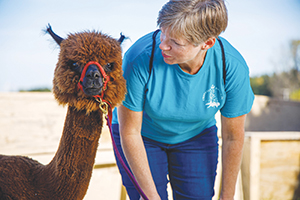
Cristo Rey Ranch volunteer Lori Quackenboss, says she is particularly fond of the ranch's alpacas, including this one named Parker.
Photo by Harle Photography, courtesy of Agnesian HealthCare
"It's all about living life here," says Sr. Stephen Bloesl, a member of the Congregation of Sister Servants of Christ the King, "and there is life all around us" with the hundreds of animals living on the property.
For decades, Sr. Bloesl, her fellow sisters and dozens of paid staff and volunteers have helped to build up the Cristo Rey Ranch, which is home to about 300 animals. The ranch is located on a 120-acre property in rural central Wisconsin that also houses the motherhouse and convent of the Sister Servants of Christ the King as well as Villa Loretto and Villa Rosa. The sisters founded the ranch, skilled nursing home and assisted living facility. While Fond du Lac, Wis.-based Agnesian HealthCare acquired Villa Loretto and Villa Rosa in October 2015, and SSM Health acquired Agnesian in January 2018, the four remaining sisters are an active presence at the facilities. Two live in the nursing home and two in the convent.
One lamb
The ranch had its humble beginnings more than 50 years ago when the sisters were operating a nursing home on the large acreage. A sister with a heart for animals took in an orphaned lamb. After that, several sisters agreed they'd like to get a goat as well. Once that goat began escaping its pen to seek out companion animals, the sisters decided they needed to take in more animals.
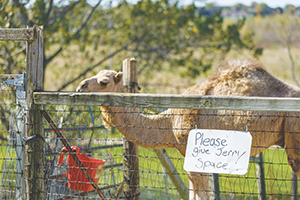
Jerry the camel has his fans among Villa residents.
Photo by Harle Photography, courtesy of Agnesian HealthCare
As the sisters realized how much the nursing home's residents enjoyed the animals — and as the sisters gained a reputation locally as compassionate souls who would adopt animals in need of a home — the animal family grew. Farm caretaker Christine Koch says many animals are rescues, some had been hoarded, some had outlived their owners, some had been donated by fans of the ranch. "Every animal has a story," Koch says.
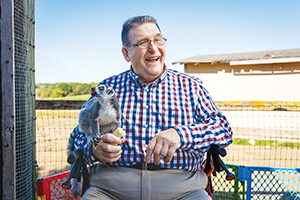
Villa Rosa resident Gerald Diederichs feeds a banana to Opie, a very sociable lemur.
Photo by Harle Photography, courtesy of Agnesian HealthCare
The ranch has evolved to include the animal pens, walking paths, gardens, barn and fields. It surrounds Villa Loretto, so residents can saunter out any time. The ranch has eight paid caretakers and about 100 volunteers. It welcomes the public, including for tours and retreats. It offers formal farm therapy programs, including for adolescents with behavioral health needs. Ranch hands take the animals out into the community for petting zoos, parades and other events.
"When you say 'Cristo Rey,' everyone seems to know about it from the petting zoos" and other community activities, says Lori Quackenboss. She has been a volunteer at the ranch for about four years. 4-H club members help her train and socialize the alpacas and other animals to interact with the public. She says of the ranch, "It just makes you happy to come here."
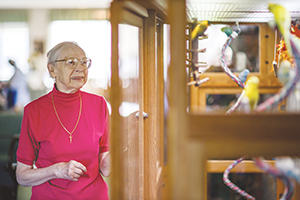
Rita Witkowski, a resident of the Villa Rosa assisted living facility, makes birdwatching part of her day.
Photo by Harle Photography, courtesy of Agnesian HealthCare
Baby boom
Sr. Bloesl has held several leadership roles at the nursing home, including director, and now focuses primarily on running the ranch. Her email address winks at her unusual vocation/occupation: [email protected]. She and her ranch crew and many among the campus' continuum-of-care staff of about 100 ensure that ranch life is interwoven with the seniors' lives.

Schroeder
Mary Jean Schroeder, an activity supervisor who is retiring in December after a 54-year career at Villa Rosa and Villa Loretto, said, "In the spring, there were lots of animal babies, and we would bring them in for visits." The residents helped bottle-feed the baby kittens, bunnies and goats and gave them plenty of attention. Schroeder says she and other staff commonly accompany the residents for walks outside and sometimes ranch hands will take them on hayrides around the acreage — even those who normally are confined to a wheelchair can ride.
Rita Witkowski, a resident of Villa Rosa assisted living, was born on a farm and says she relishes going out onto her balcony to see the sheep and horses in the adjacent field. She enjoys walking around the ranch, visiting with the animals. "The animals love us," she says. "They are 'people animals.'" The ranch's camel, Jerry, is one of her favorites.
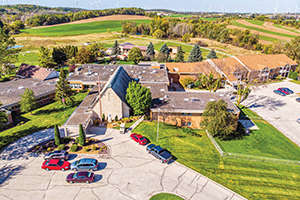
The Cristo Rey Ranch is part of a senior services campus. The Villa Loretto nursing home is immediately behind the chapel. The Villa Rosa assisted living facility is located elsewhere on the property.
Photo by Harle Photography, courtesy of Agnesian HealthCare
Retired dairy farmer Gerald Diederichs, a resident of Villa Rosa, says being around so many animals makes him feel right at home. He is especially fond of the ranch's cows — he had donated some of them to the ranch.
Marilyn Johnson, another resident, says her grandchildren love to come and visit, and they are always drawn to the animals.
Jenna Floberg, executive director of Villa Loretto and Villa Rosa, says people are happier around animals and that includes residents, their family and friends, staff, and community members.
Therapeutic value
Ranch caretaker Bernard Mueller is a retired dairy farmer who had worked at the Villa as a certified nursing assistant. He says the animals have a therapeutic effect on residents that "does as much good as medicine."
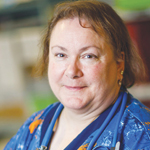
Pickart
Schroeder says it is very common for staff to calm an agitated resident in cognitive decline or a resident nearing death with a visit from that person's favorite animal. Nurse Mary Pickart agrees the animals are an "amazing tool" for reaching residents with dementia. Being close to animals may spark pleasant memories, and that is especially so for residents who have grown up on farms. "The animals may open up a bridge we hadn't been able to open," she says.
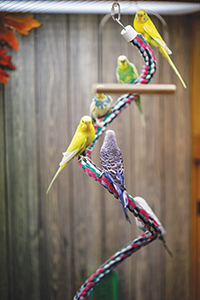 The ranch also has a respite program for children with behavioral health concerns, and many of these children have become close to animals. The ranch welcomes up to four children at a time for weekend stays in a guest house on the property. Participating children are clients of a Fond du Lac social services agency. They can take advantage of equine therapy. The ranch also hosts a summer camp for children with autism and their neurotypical peers.
The ranch also has a respite program for children with behavioral health concerns, and many of these children have become close to animals. The ranch welcomes up to four children at a time for weekend stays in a guest house on the property. Participating children are clients of a Fond du Lac social services agency. They can take advantage of equine therapy. The ranch also hosts a summer camp for children with autism and their neurotypical peers.
Sr. Bloesl admits to fleeting doubts about the emphasis on animal husbandry at a senior care facility: "Sometimes I've wondered, 'Is this really what the Lord wants?' But then I see how all of this is impacting people, and I know it is all worth it."
Follow the links below to learn more about life on the farm:
Sr. Stephen and Opie the lemur
Boy feeding goats
Alpacas on the farm
Research shows animal-assisted therapy can have positive impact on health
Researchers studying the effects of animal-assisted therapy have found that it can improve people's physical and mental health.
According to a UCLA Health analysis of research on animal-assisted therapy, being with animals and interacting with them — such as by petting them — has been found to elevate people's moods, lower anxiety, increase relaxation, reduce loneliness, boost mental stimulation and provide an escape or distraction from concerns.
The same research analysis said animal-assisted therapy has been found to have an impact on physical symptoms as well: it can lower people's blood pressure and improve their cardiovascular health, slow the breathing of people experiencing anxiety and diminish the feeling of physical pain.
That research summary also noted that animal-assisted therapy has been shown to improve the use of language and the social interactions of children with autism.
And in a 2014 article on the Psychology Today blog, teacher, author and researcher Hal Herzog summarizes dozens of animal-assisted therapy research studies, saying that the therapy has produced beneficial results in patients with Alzheimer's disease, schizophrenia, developmental disabilities and Down syndrome. Herzog did caution, however, that many clinical studies of animal-assisted therapy use weak methodologies, and so more rigorous studies are needed to test some research results.